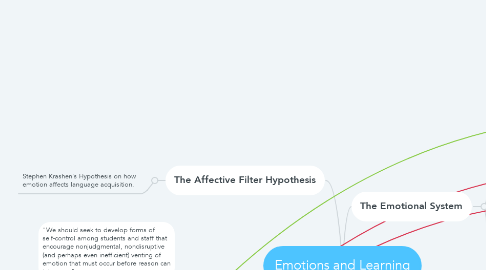Emotions and Learning
by Matthew Michelson


1. The Affective Filter Hypothesis
1.1. Stephen Krashen's Hypothesis on how emotion affects language acquisition.
2. Classroom Applications
2.1. "We should seek to develop forms of self-control among students and staff that encourage nonjudgmental, nondisruptive (and perhaps even inefficient) venting of emotion that must occur before reason can take over."
2.2. Schools should teach metacognitive skills to mitigate emotional impacts.
2.3. "Activities that emphasize social interaction and that engage the entire body tend to provide the most emotional support."
2.4. Try to replicate the emotional setting to create contextual memory.
2.5. "Emotionally stressful environments are counterproductive because they can reduce students' ability to learn."
3. The Emotional System
3.1. Peptides: Molecular Messengers
3.1.1. Spark increased or decreased activity when they attach to the outside of cell.
3.1.2. Travel via the neural networks, circulatory system, and air passages
3.1.3. Types
3.1.3.1. Neuropeptides
3.1.3.1.1. Endorphin
3.1.3.2. Hormones
3.1.3.2.1. Cortisol
3.2. Brain and Body Structures dealing with emotion.
3.2.1. Brain
3.2.1.1. The Brain Stem and Limbic System
3.2.1.1.1. Amygdala complex and hippocampus can affect the strength of a memory. This can cause repressed memories and a tendency to avoid triggers of that event and similar circumstances may cause the poor recollection of the original event.
3.2.1.1.2. Thalamus and hypothalamus
3.2.1.2. Cortex
3.2.2. Endocrine System
3.2.3. Immune System

